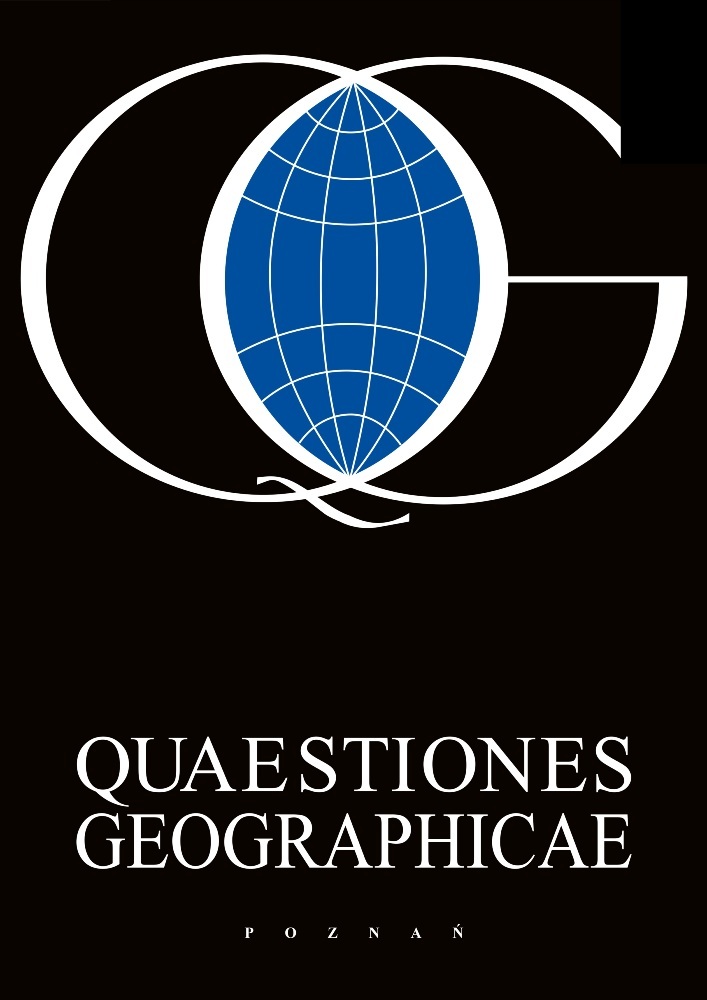Abstract
The paper present the energy budget of the downstream part of lowland Świder River, right tributary of the Vistula River in Mazovian Lowland, Poland. Heat fluxes were calculated on the example of four days, representing different meteorological and vegetative conditions. Results confirmed the dominant role of radiation, which accounted for an average of 90.7% and 79.7% gains and losses of thermal energy. Participation of non-radiative components proved to be far less crucial; the average contribution of condensation, sensible heat transfer, bed conduction and friction in energy gains accounted respectively to 0.0%, 0.6%, 2.9% and 5.9%, while the average contribution of evaporation, sensible heat transfer and bed conduction in energy losses reached respectively 4.5%, 1.1% and 14.6%. The results showed significant effect of riparian vegetation and cloud cover on river heat fluxes
References
Alduchov O.A., Eskridge R.E., 1996. Improved Magnus Form Approximation of Saturation Vapor Pressure. Journal of Applied Meteorology 35: 601-609.
Allan J.D., Castillo M.M., 2007. Stream Ecology. Structure and Function of Running Waters. Springer, Dordrecht.
Armour C.L., 1991. Guidance for evaluating and recommending temperature regimes to protect fish. U.S. Fish and Wildlife Service Instream Flow Information Paper 28, Biological Report 90, Washington DC.
Benyahya L., Caissie D., Satish M.G., El-Jabi N., 2012. Longwave radiation and heat flux estimates within a small tributary in Catamaran Brook (New Brunswick, Canada). Hydrological Processes 26: 475-484. DOI 10.1002/hyp.8141.
Bowen I.S., 1926. The ratio of heat losses by conduction and by evaporation from any water surface. Physics Review 27: 779-787.
Boyd M., Kasper B., 2003. Analytical methods for dynamic open channel heat and mass transfer: methodology for the Heat Source Model Version 7.0. Watershed Sciences Inc., Portland, OR, USA.
Buck A.L., 1981. New Equations for Computing Vapor Pressure and Enhancement Factor. Journal of Applied Meteorology 20: 1527-1532.
Deas M.L., Lowney C.L., 2000. Water temperature Modeling Review. California Water Modeling Forum, Central Valley, California.
Evans E.C., Petts G.E., 1997. Hyporheic temperature patterns within riffles. Hydrological Sciences-Journal-des Sciences Hydrologiques 42: 199-213.
Evans E.C., McGregor G.R., Petts G.E., 1998. River energy budgets with special reference to river bed processes. Hydrological Processes 12: 575-595.
Garner G., Malcolm I.A., Sadler J.P., Millar C.P., Hannah D.M., 2014. Inter-annual variability in the effects of riparian woodland on micro-climate, energy exchanges and water temperature of an upland Scottish stream. Hydrological Processes. DOI 10.1002/hyp.10223.
Hannah D.M., Malcolm I.A., Soulsby C., Youngson A.F., 2008. A comparison of forest and moorland stream microclimate, heat exchanges and thermal dynamics. Hydrological Processes 22: 919-940. DOI 10.1002/hyp.7003.
Hebert C., Caissie D., Satish M.G., El-Jabi N., 2011. Study of stream temperature dynamics and corresponding heat fluxes within Miramichi River catchments (New Brunswick, Canada). Hydrological Processes 25: 2439-2455. DOI: 10.1002/hyp.8021.
Hondzo M., Stefan H.G., 1994. River bed heat conduction prediction. Water Resources Research 30: 1503-1513.
Malcolm I., Soulsby C., Hannah D.M., Bacon P.J., Youngson A.F., Tetzlaff D., 2008. The influence of riparian woodland on stream temperatures: implications for the performance of juvenile salmonids. Hydrological Processes 22: 968-979. DOI: 10.1002/hyp.6996.
Morin G., Couillard D., 1990. Predicting river temperatures with a hydrological model. In: Cheremisinoff N.P. (eds), Encyclopedia of Fluid Mechanic, Surface and Groundwater Flow Phenomena. Gulf Publishing Company, Hudson, Texas, USA: 171-209.
Theurer F.D., Voos K.A., Miller W.J., 1984. Instream Water Temperature Model. Instream Flow Information Paper 16, U. S. Fish and Wildlife Service.
Webb B.W., Zhang Y., 1997. Spatial and seasonal variability in the components of the river heat budget. Hydrological Processes 11: 79-101.
Webb B.W., Zhang Y., 1999. Water temperatures and heat budgets in Dorset chalk water courses. Hydrological Processes 13: 309-321.
Westhoff M.C., Savenije H.H.G., Luxemburg W.M.J., Stelling G.S., Van de Giesen N.C., Selker J.S., Pfister L., Uhlenbrook S., 2007. A distributed stream temperature model using high resolution temperature observations. Hydrological Earth System Sciences 11: 1469-1480. DOI 10.5194/ hess-11-1469-2007.
Xin Z., Kinouchi T., 2013. Analysis of stream temperature and heat budget in an urban river under strong anthropogenic influences. Journal of Hydrology 489: 16-25. DOI 10.1016/j.jhydrol.2013.02.048.
License
© Faculty of Geographical and Geological Sciences, Adam Mickiewicz University.
This work is licensed under the Creative Commons Attribution-NonCommercial-NoDerivatives 3.0 License.
